Author’s Note: I actually wrote a few drafts of this story in the past few years, but never got around to actually publishing it because none of the drafts felt compelling enough to release to the public. In that time, there have been some significant changes to the competitive High Power (Service) Rifle discipline. Notably was the announcement that the NRA would no longer take part in the National Matches at Camp Perry, and will move the NRA Nationals to another location/venue. The NRA also recently announced their own “Distinguished Rifleman” award, completely separate from the CMP.
Due to the recent changes to what is competitive High Power Service Rifle and the eventual changes to the discipline as we now know it, I felt it necessary to finally “pull the trigger” so to speak, and publish this story.
That being said, the following story is an accurate telling of how I began the quest for the Distinguished Rifleman badge, the difficulties in earning the Distinguished Rifleman badge, and how I eventually obtained the title.
Every now and then and I will get inquired about the gold acorn lapel pin on my suit jacket at the office or at an evening event, or about the gold acorn sticker on my laptop. The gold acorn is the image of my Distinguished Rifleman badge and the story behind how I obtained it is something I have been meaning to write for quite some time now.
During the mid-2000s, my shooting endeavors took a huge focus towards High Power Service Rifle. For those not familiar with High Power Rifle, also referred to as Across the Course, traditional High Power Rifle, and National Match Rifle, it is a competitive shooting discipline that incorporates three positional shooting (standing, sitting/kneeling, and prone) with a rifle at distances of 200, 300, and 600 yards.
While I initially began shooting this style of competition because I wanted to simply challenge myself and improve my marksmanship, I found myself chasing the goal of Distinguished Rifleman.
First off, what is Distinguished Rifleman?
Distinguished Rifleman is one of two awards (the other being Distinguished Pistol Shot) currently authorized by the US Government for excellence in marksmanship competition. Title 36 of the U.S. Code, Chapter 407, Subchapter 2 (36 USC §40722 [3]) defines the of the Civilian Marksmanship Program in this regard:
The functions of the Civilian Marksmanship Program are—
(1) to instruct citizens of the United States in marksmanship;
(2) to promote practice and safety in the use of firearms;
(3) to conduct competitions in the use of firearms and to award trophies, prizes, badges, and other insignia to competitors;
(4) to secure and account for firearms, ammunition, and other equipment for which the corporation is responsible;
(5) to issue, loan, or sell firearms, ammunition, repair parts, and other supplies under sections 40731 and 40732 of this title; and
(6) to procure necessary supplies and services to carry out the Program.
Today’s Distinguished Rifleman and Pistol Shot awards originated from the Distinguished Marksman title first issued in 1884 and Distinguished Marksman badges first issued in 1887 for Army soldiers in competitive matches. The other branches of the military began their own Distinguished Marksman programs in the early 1900s. The Office of the Director of Civilian Marksmanship was created in 1903 (War Department Appropriations Act) in order to promote rifle marksmanship skills for civilians in the event there is a call to war. Later in 1923, civilian shooters became eligible for the Distinguished Marksman award.
Eventually in the 1950s, the award of Distinguished Marksman became the Distinguished Rifleman award we know today.
All historical information above was sourced from:
- In Distinguished Company by Dick Culver
- Civilian Marksmanship Program – Wikipedia
With that history lesson, how do you become a Distinguished Rifleman?
This will vary slightly depending on your branch of service or if civilian.
But for a civilian such as myself, achieving Distinguished Rifleman requires getting thirty (30) Excellence in Competition (EIC) points. EIC points are obtained by scoring in the top 10% of non-Distinguished shooters of an Excellence in Competition match, where a gold (10 points), silver (8 points), or bronze (6 points) LEG award maybe issued.
Note: The origin of the term ‘LEG’ in the context of LEG points or LEG awards is unknown.
This is where it gets interesting, though.
The award points for the top 10% of non-Distinguished shooters in an EIC match is directly dependent on the number of non-Distinguished shooters in that EIC match. This alone is a bit complex, and is defined in the Civilian Marksmanship Program Service Rifle and Service Pistol Rulebook. But essentially, if there are less than six (6) non-Distinguished shooters in an EIC match, no EIC / LEG points will be awarded.
If there are at least six (6) non-Distinguished shooters in an EIC match, then at least one bronze EIC (6 points) award will be given out. There must be at least 16 non-Distinguished shooters in an EIC match to give out two LEGs (one silver and one bronze). There must be at least 36 non-Distinguished shooters in an EIC match to give out a gold LEG award (total of four LEGs: one gold, one silver, two bronze). The number of LEGs awarded in an EIC match increases with the number of non-Distinguished shooters in a given EIC match (hence the top 10% of non-Distinguished shooter scores).
Then there is actually a limit on the number of EIC matches a non-Distinguished shooter can shoot in and earn points. A non-Distinguished shooter is limited to only five (5) EIC matches per calendar year (when I was still competing, the limit was four, but was recently increased in 2016). This means that if a non-Distinguished shooter participates in five EIC matches, they cannot participate and earn LEG points in any more EIC matches until the next calendar. This prevents a shooter from shooting hypothetically 20 matches in one year to get the requisite 30 points to go Distinguished.
But then there is also a stipulation that at least one of your EIC / LEG awards is a silver or gold (10 or 8 points), also dubbed a Hard LEG. This actually means that a non-Distinguished shooter could get five bronze LEGS at six points each for a total of 30 points, but will not be awarded the title of Distinguished Rifleman because none of the LEGs earned were a Hard LEG.
There is one exception to this. Any LEG award obtained at the annual National Match EIC is considered a Hard LEG at 10 points whether it is a bronze, silver, or a gold. So it is possible for a non-Distinguished shooter to get all bronze LEGs to go Distinguished, if and only if at least one of those LEGs was obtained in the National EIC at Camp Perry (10 + 6 + 6 +6 + 6 = 34 points, which exceeds 30). This referred to as “Bronzing Out.”
As you can see, the way EIC / LEG points are awarded in an EIC match, and the limit on the number of EIC matches makes achieving thirty (30) Excellence in Competition points a challenge. What makes going Distinguished difficult for many is simply getting to a match that has a Hard LEG (at least 16 non-Distinguished shooters for one silver and one bronze award).
Due to the dwindling participating in High Power Service Rifle, EIC matches have lower attendance numbers than in prior years, and regions with a small High Power community might only have one ‘big’ match a year where there is a Hard LEG (e.g. Service Rifle Championship for that respective State). But even if a non-Distinguished shooter enters a match with a Hard LEG, they obviously need to get the highest non-Distinguished score.
One minor, albeit critical detail is that there are no sighters in EIC matches. Every competitor must know everything about their gun, particularly zeros, and must be adept at wind calls, particularly in the rapid fire stages. One improper sight adjustment due to forgetfulness or a bad wind call can cost you LEG points.
All these factor – no sighters, the hard limit on the number of EIC matches you may participate in per year, and the necessary number of non-Distinguished participants to grant LEG awards for the match – make achieving Distinguished a fairly difficult task.
This is why the title of Distinguished Rifleman (and Distinguished Pistol Shot) is coveted and revered by competitive High Power shooters, and for many, is never obtained even after a lifetime of competing.
So how did I even begin this quest for Distinguished Rifleman?
It actually started as a result of me getting my 03 Federal Firearms License, Collector of Curios and Relics. In the early 2000’s, I got into collecting military surplus firearms and I eventually wanted to get an M1 Garand from the CMP (the CMP sells surplus US military firearms). One of the criteria of purchasing a firearm from the CMP is proof of marksmanship participation, and participating in a shooting match.
It just so happened the CMP had just started a West coast annual event called the Western Games in 2005. The inaugural CMP Western Games would be two days of CMP Garand / Springfield / Military Vintage (aka GSM) matches to be held at Marine Corps Base Camp Pendleton. The CMP would also bring rifles and ammo for inspection and sale.
The CMP Games matches are considered introductory events that get people acclimated to shooting full course High Power Service Rifle (Across the Course).
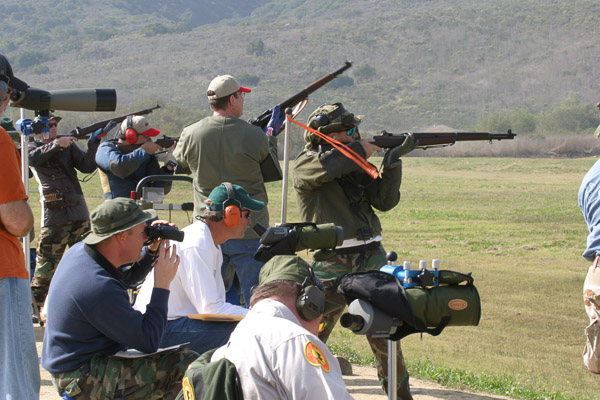
Given that MCB Camp Pendleton is only a short drive for me, I figured the CMP Western Games GSM match would be a good opportunity to get an official match on the record to be eligible to get an M1 Garand, as well as pick one out in person.
I was primarily a recreational shooter up until that point. I would just spend my time at the range shooting paper for fun and the enjoyment of firearms. I quickly glanced over the course of fire for the CMP Games and did not really put too much thought in in, except to make sure I had the minimal gear to participate in the match.
So I showed up with my M96 Swedish Mauser with USGI cotton web sling, some 6.5×55 Swede handloads with 142gr Sierra Match Kings, my BLACKHAWK rollup shooting mat and shot in the Military Vintage category of the May 2005 CMP Western Games.
The CMP maintains historical records of all CMP affiliated matches and the results are available online through the CMP Club and Competition Tracker web site, so my very first competitive match score is saved for posterity. That score?
- 90-0x slow fire prone
- 70-0x rapid fire prone
- 58-0x slow fire standing
- Total: 218-0x
For those that don’t know, the scoring 10 shots with maximum of 10 points each (X = 10 points, but used for tie breakers) for a total of 100 points (and 10 X’s) for each stage, three stages.
That means I shot a miserable 218 out of 300 with no X count. That’s pretty bad and I will admit I was absolutely terrible.
As you can see above, my standing was atrocious. I didn’t shoot with a shooting coat because I didn’t own one and had never really shot 200 yard standing in my life up to that point.
I picked out an M1 Garand at the end of the day, but I ended up leaving the match a bit unsatisfied. I was unhappy with my performance and thought that I could shoot better. I thought that I should shoot better.
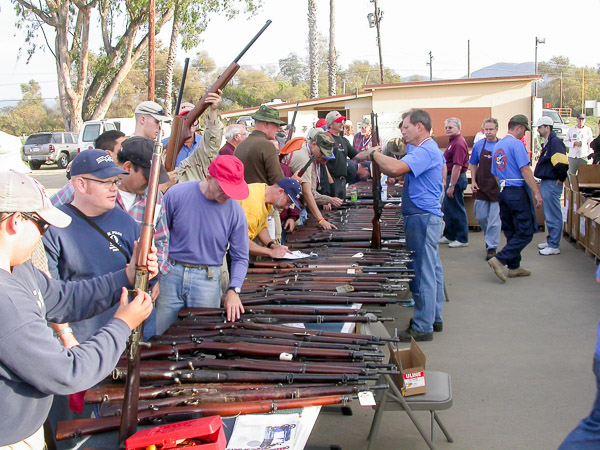
I decided to spend my days at the range practicing all three positions – standing, sitting, and prone – to shoot in the next Western Games match in November of that same year (2005).
It just so happened that the CMP decided to work with Creedmoor Sports – at the time located in Oceanside, California – who held an event in November called the Creedmoor Cup, also at Marine Corps Base Camp Pendleton. The Creedmoor Cup is an NRA Approved High Power Rifle match, not quite an NRA Regional, but of equivalent stature for High Power Rifle shooters (Service Rifle and Match Rifle). The CMP would hold the Western Games along side the Creedmoor Cup and add a CMP Excellence in Competition match to the match program, thus creating the CMP Western Games and Creedmoor Cup event (which is still an annual event in the Fall, now held in Phoenix, Arizona).
So between May 2005 and November 2005 I spent every other weekend shooting the M1 Garand from position.
I slowly started acquiring High Power competition gear, as well. Most notably I acquired a basic shooting coat from Creedmoor Sports, a Kowa 661 with 25x LER eyepiece, a Jim Owens collapsible scope stand, and a Ray-Vin shooting cart.
I was also trying to gather as much information as possible. I read “Sight Alignment, Trigger Control & The Big Lie” and “Leather Sling and Shooting Positions” by Jim Owens, as well as various High Power related articles on the Internet.
So November 2005 rolled around and I shot in three matches, the first CMP GSM match with the M1 Garand, the second CMP GSM match with the M96 Swedish Mauser, and a third match called the As-Issued Excellence in Competition match with the M1 Garand.
I ended up doing quite well in my second rifle competition. In the CMP GSM match with the M1 Garand I shot:
- 93-0x slow fire prone
- 96-1x rapid fire prone
- 86-0x slow fire standing
- Total: 275-1x
In the CMP GSM match with the M96 Swedish Mauser I shot:
- 88-0x slow fire prone
- 89-2x rapid fire prone
- 84-0x slow fire standing
- Total: 261-2x
As you can see, my scores were a huge improvement to the 218-0x I shot in my first CMP Games match. Not to mention the 275-1x with the Garand earned me a Silver CMP Games Garand medal and the 261-2x with the Swedish Mauser earned me a Bronze CMP Games Military Vintage medal.
As far as the As-Issued Excellence in Competition match, it is supposed to be an introductory EIC match to further bridge the newer ‘games’ shooters into the more ‘serious’ EIC (and NRA High Power) matches, where an introductory 4 point LEG can be earned. The course of fire is similar to the CMP Games matches, except it adds and additional stage of rapid fire sitting or kneeling.
I ended up shooting a score of:
- 92-1x slow fire prone
- 93-0x rapid fire prone
- 86-1x rapid fire sitting
- 87-0x slow fire standing
- Total: 358-2x
I didn’t score high enough place in the top 10% of non-Distinguished shooters in the As-Issued EIC match to earn points. But what it did do for me is get inspired to improve my shooting more.
I remember trying to shoot with an open leg position, and didn’t even rest my firing elbow against my thigh. Afterwards, I thought to myself I was doing it wrong and put the sitting position on my list of things to learn/improve. Not to mention my Silver and Bronze CMP Games medals got me eager to get Gold CMP Games medals.
After the 2005 CMP Western Games and Creedmoor Cup, I continued my practice and was preparing myself for the eventual 2006 CMP Western Games.
But during this window of time came the turning point.
One day in early 2006, I was practicing at my regular range, shooting the M1 Garand in 200 yard standing. As I was on the firing line, looking through my spotting scope to locate the shot I threw out of the black (worse than a 9), I was thinking to myself, “I have all the gear to shoot NRA High Power Across the Course. Why am I spending all this energy, time, and money practicing shooting an as-issued, off the rack rifle from 1944 when I could just shoot the AR-15, a rifle which I owned since the mid-90s and is far more accurate, in full course competition?”
I realized right then that I should just transfer all of my energy and efforts into NRA/CMP High Power Rifle with the AR-15 in Service Rifle.
Service Rifle at the time (and until the start of 2016) were defined by three specific rifles:
- M1 Garand
- M14 (or civilian equivalent)
- M16 (or civilian equivalent)
The key points with using any of above three rifle types for Service Rifle competition is that each one had to be configured in the traditional military issue style (with some allowances). But for the M16/AR15, the main points were that the rifle be an A2 or A4 style rifle with the carry handle sight, and A2 stock and A2 grip, with a 20″ barrel. So basically, your classic M16A2, except you could add a better trigger (as long as it was a 2-stage with a minimum of 4.5lb trigger pull) and “National Match” style sights (finer adjustments, hood aperture, etc).
So I ended up buying a CMP Service Rifle upper from White Oak Armament and a Geissele Hi-Speed National Match (large pin) trigger and converted my Colt Sporter 16″ into a National Match AR-15 A2 style Service Rifle in October 2006.
That gave me about 4-5 weekends to practice with the AR-15 Service Rifle in preparation for the 2006 Creedmoor EIC and Cup matches. Those would be my very first true distance Across the Course match, shot at 200 yards, 300 yards, and 600 yards.
The CMP and Creedmoor Sports ended up scheduling the 2006 Creedmoor Excellence in Competition match before the Creedmoor Cup match, so my very first official High Power Service Rifle match was the 2006 Creedmoor EIC.
I ended up shooting:
- 92-0x 200 yard slow fire standing
- 90-0x 200 yard rapid fire sitting
- 94-0x 300 yard rapid fire prone
- 168-2x 600 yard slow fire prone
- Total: 444-2x
That 444-2x isn’t great, but fairly decent for a first time shooter. I ended up shooting a 750-14x in the 2006 Creedmoor Cup, my very first NRA High Power rifle match (172-0x, 195-3x, 193-6x, 190-5x).
After the 2006 Creedmoor Cup, I was hooked and was all in. I ended up becoming a regular at the monthly Santa Margarita Gun Club NRA Approved matches (held at MCB Camp Pendleton) and after two more matches and lots of practice time at my local range, I got my first NRA Classification of Master in High Power Rifle (second only to High Master).
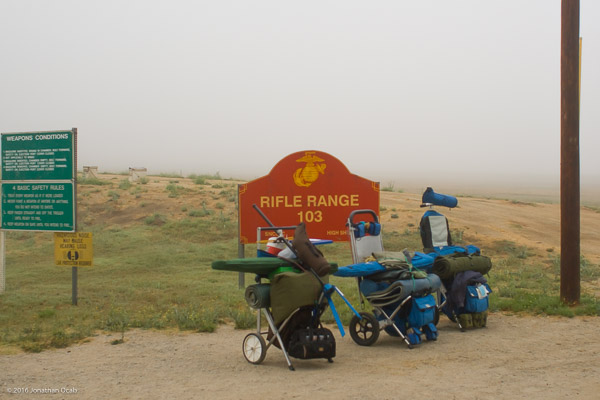
But more importantly, the 2006 Creedmoor Cup is when I began the chase for Distinguished Rifleman.
I found myself spending every weekend since 2006 at the range either practicing, or at an actual match.
Yes, I know the above video looks like it was recorded with a potato. But this was an old video from 2007 recorded on an older camcorder and uploaded to YouTube back when YouTube still did not support HD.
I would go to MCB Camp Pendleton, MCAGCC Twentynine Palms, Coalinga for State Championships, Phoenix (venue the Western Games moved to), and other locations for matches. I literally did not fire any other firearm but the AR-15 Service Rifle during that time.
During the time, I also went to several EIC matches (remember: limit of three EIC matches, plus National Matches, every calendar year). There were some where I shot poorly. Then there were others were I shot “First Leather” (unofficial term for the top score that didn’t get LEG points in an EIC match).
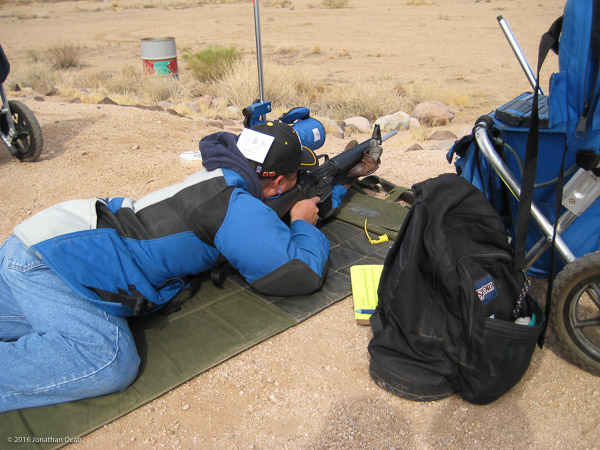
Those matches definitely tested my resolve. I often found myself beating up myself mentally for dropping points in certain stages of those matches. I would review my data book and focus on the 7 for shot 12 on the 600 yard slow fire prone stage, or the 8 for shot 5 on the 200 yard slow fire standing stage. I would think that if shot an 8 or 9 instead of that 7, and a 9 or 10 instead of that 8, I could have placed higher and earned a LEG.
But I fought through those times, and in between the bad matches, there were those were I earned LEG points, including scoring first in a US Navy Pacific Fleet military EIC match.
The EIC points slowly accumulated to where I was one LEG award (24 points accumulated, only needed 6 more points / Bronze) away from making Distinguished Rifleman.
Then on the 19th of April in 2009, in a small Excellence in Competition match held at MCB Camp Pendleton by the Santa Margarita Gun Club, I fired a respectable 475-9x to shoot the top non-Distinguished score of the match, and earn the final LEG points to get to thirty Excellence in Competition points for the title of Distinguished Rifleman.
I cannot explain the feeling of accomplishment and relief that came over me when the scores were collected and announced at the end of that April 19, 2009 match. From my very first EIC match in November 2006 to that April 2009 EIC match, there were lots of ups and downs. Lots of rounds put down range practicing at my local range. Lots of hours spend dry firing at home.
But I made it.
While it is a badge, my Distinguished Rifleman medal has never been worn because such a thing is an odd thing to wear on civilian clothes, so it has been placed in a frame and adorned on my wall in my home.
Of course, the title of Distinguished Rifleman does not mean I am a great shooter by any means. When I stopped competing in High Power Service Rifle, I never made NRA High Master (stuck at Master), nor did I win any Regional, State, or a National Championship. I do think I was a fairly solid shooter right up to when I stopped competing. Although, I will admit that my skills have diminished since then.
If anything, the title signifies the accomplishment of a goal that I set out to achieve when I started competing in High Power Service Rifle, and as a marksman, the achievement is something I am quite proud of. Which is why I will wear the Distinguished Rifleman pin on my suit lapel, or on the back of one of my hats, and have a Distinguished Rifleman decal on my MacBook Air.
So whenever someone inquires about my lapel pin or the sticker on my laptop, most of the time it ends up being a fairly quick answer of it being a “marksmanship award,” and without the conveyance of the effort and heart that I put into obtaining the award.

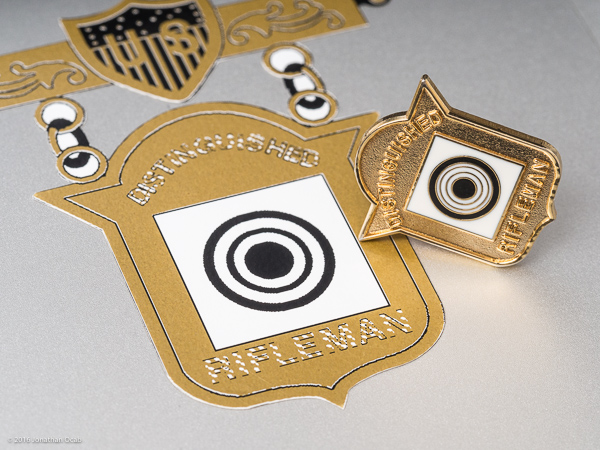
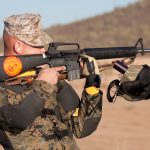
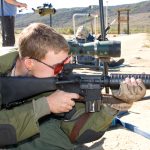
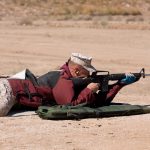
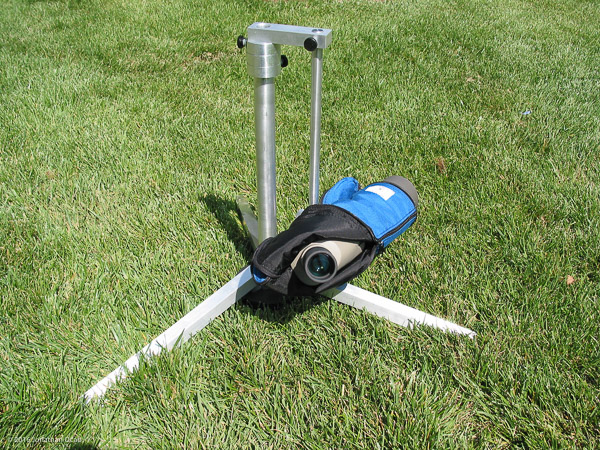
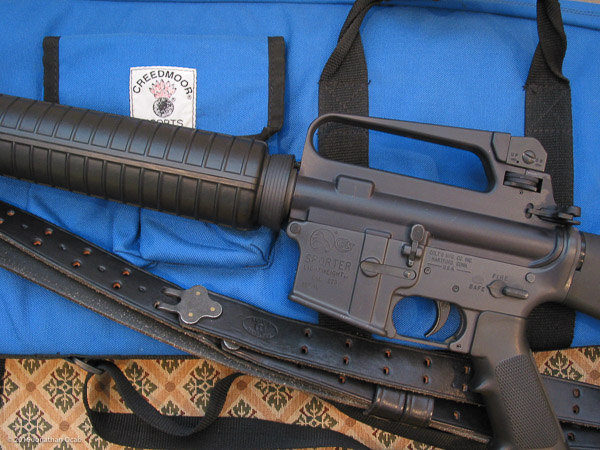
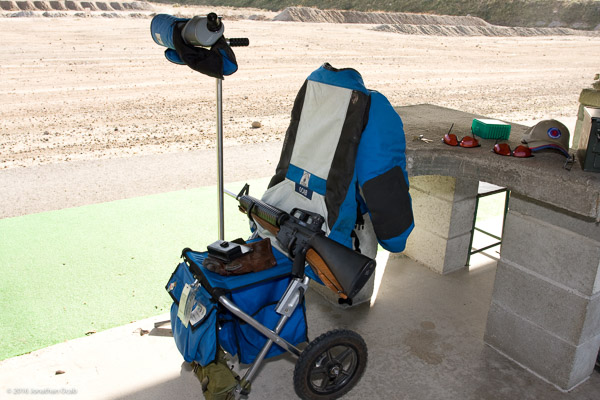
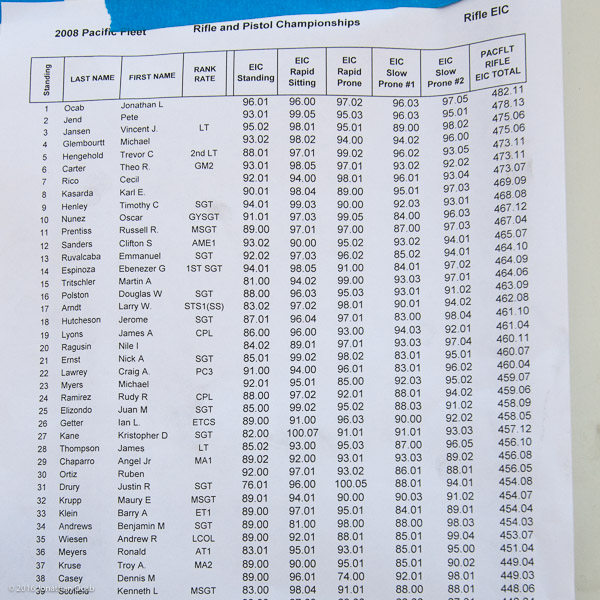
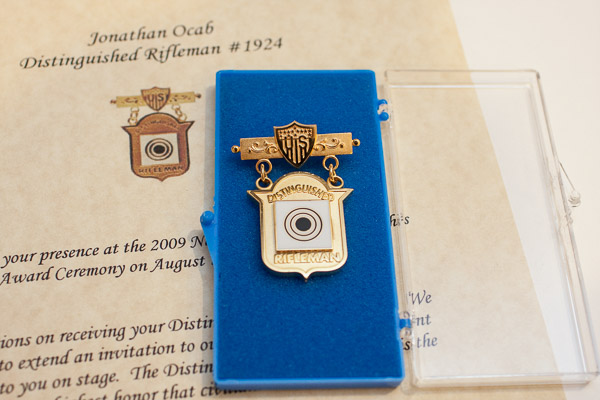
Nestor
Great article on working hard to achieve a personal goal! Shooting is an art form that I am in awe of.
2018 SHOT Show After Action Report – Part 1 – ocabj.net
[…] Geissele Hi-Speed NM Service Rifle trigger for my Colt large pin lower, and the rest is history, culminating in my Distinguished Rifleman badge in 2009. As far as 2-stage AR-15 triggers, I have been a huge Geissele […]